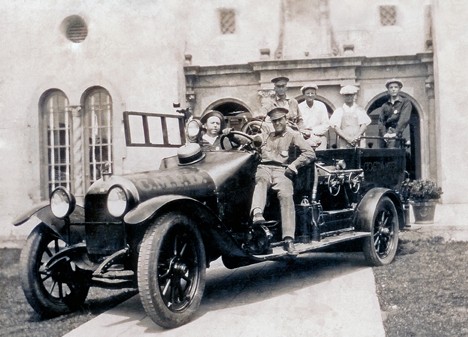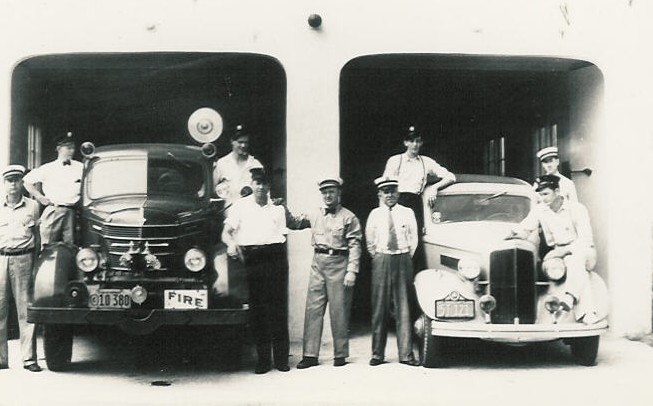History of Costa Mesa Fire Department By Fred McDowell
At the turn of the 20th century, the area we know as Costa Mesa was actually three separate communities. The village of Fairview was in the northwest part of the city, near the modern intersection of Harbor and Adams. The farming community of Paularino, named after one of the original 19th century Spanish Ranchers, occupied the northeastern part of the city from Baker up to the South Coast Plaza area. The third and largest was the village of Harper, located near today’s Triangle Square mall. In the early 1900’s, the area was agricultural and sparsely populated. In those days, Orange County was often the destination of people from the greater Los Angeles area who wanted to “escape to the country." Travelers would journey down Newport Blvd, past the Sakioka family’s vast lima bean fields near Paularino, into the apple groves surrounding the village of Harper. Roadside produce stands lined the boulevard, (the city’s first paved road) enticing visitors to stop in for a snack on their way home from the nearby beach at Newport. In 1920, the local inhabitants held a contest to pick a new name for the general area around Harper. Several names were submitted, many referring to the apples that had made the area quite famous. Ultimately, Ms. Alice Plumer received $25.00 for submitting the Spanish name, “Costa Mesa," meaning “coastal tableland." The area grew slowly but steadily and by 1924, the population had increased to over 2,400. At this time, the Orange County Board of Supervisors governed the still-unincorporated area of Costa Mesa. Fire protection for the County of Orange was under the jurisdiction of the California Department of Forestry. In the early 1900’s a few individuals battled fires with a hand-drawn hose cart that was stored at Emil Greener’s place on Newport Blvd. After a number of disastrous fires ravaged the community, a dedicated group of citizens formed the Costa Mesa Volunteer Fire Department in 1925. Chief Fred Bush led the small group, who responded in a Ford Model T equipped with a “chemical” (soda-acid) extinguishing system. The rig was stored in the Veile Sheet Metal Shop, next door to the feed store. There was a large cast iron bell on the tin shed that was used to call the volunteers.
Photo above is CMFD volunteers, September 1939 In 1935, the volunteer fire department made its headquarters in Wallace’s Hi-Way Garage on the east side of Newport Blvd. In 1938, they moved once again to the new County Fire Hall at 121 Rochester St, Costa Mesa’s first true “fire station." Apparatus at this time included a new 1938 International front-mounted 550 GPM pumper and 1933 rescue panel truck, equipped with one of the largest resuscitators in the County. The outbreak of World War II brought many changes to Costa Mesa. The Army Air Corps established the Santa Ana Army Air Base in the area north of the city. Despite the name, the installation was not an airfield, but rather a school for training pilots, navigators and bombardiers in the Army Air Corps. At the height of the war, the base itself was a small city (complete with its own fire department) and had a population of over 23,000. At the war’s end, many veterans relocated to the Costa Mesa area to purchase one of the many affordable homes in the area. As the city grew, so did the volunteer fire department. In 1947, a Bean 500 gallon high-pressure tank truck was purchased from the Army as surplus. Four years later, the County gave an unwanted 1931 American LaFrance 500 GPM pumper to the volunteers. The old pumper had originally belonged to the City of Palm Springs and on one alarm, one of its front wheels fell off. Although it was sold back to the Palm Springs Firefighter’s Association in 1981, one piece of the little truck remains in the City of Costa Mesa. Highly polished, the rig’s brass bell is a memorial to those members of the Costa Mesa Fire Department who have passed away.
Photo above is Delivery of the Bean Rig at Rochester Station, 1947 The City of Costa Mesa was incorporated on June 29, 1953. With a population of 16,000 and an area of 3.5 square miles, the new city was centered around the old village of Harper. Few changes occurred until 1954, when the city created the position of Fire Prevention Officer and hired Ralph Lee to become the first paid officer in the fire department. Lee had received flight training at the Santa Ana Army Air Base and worked for the Redondo Beach Fire Dept. after the war. In addition to fire prevention, his duties included the training and supervision of the 28 volunteers. On March 5th, 1956, the City Council passed Ordinance No. 123. This opened the positions of Fire Chief, Assistant Fire Chief, Captain, Engineer and Hoseman, thus creating the regular paid Costa Mesa Fire Department. The old Rochester Street fire station was bought back from Orange County for $15,000 (the volunteers had first sold it to the County for $1.00). Ralph Lee was selected as the first career Fire Chief and received a starting salary of $440.00 per month. The CMFD was rated a “9” by the I.S.O. and seven pieces of equipment were in the inventory:
Although the CMFD had been established in March of 1956, the actual change from county control did not occur until four months later. On Sunday, July 1st, 1956 the career Firefighters, Engineers Ray Gallagher and Lee Trembley and four Hosemen, Tom Knight, Martin Kooken, Bob Van Drimlen and Arch Locke reported for duty at 0800. Together they and the volunteers responded to three fires that day. There were two shifts, “A” and “B”, each consisting of an Engineer and two Hoseman. For the first two weeks, the men worked eight hours each day in addition to the regular shift work. Time was spent learning hose lays, pumping, ladders, rescue procedures and other skills. For approximately 15 days a month, there were only two men on duty; the other man was on his day off. According to Captain Arch Locke “when an alarm was received, the Hoseman, responded alone most of the time. Rescues were always a one-man operation. If an alarm was received during the day, you could depend on one of the three volunteer dispatchers we had…if you were lucky.” The life of a firefighter in 1956 was much different from what we know now. The men worked a “day on/day off” schedule for 16 days and then had five days off in a row. The pay was low; Starting Hosemen made only $319.00 per month and “overtime” was paid “straight” time. Class “C” uniforms consisted of dark blue “dungaree” trousers and light blue Chambray shirts. No shoulder patches were worn except on the class “A” jackets. Helmets and turnouts were all black; Captains were identified by a white stripe down the middle of their helmets. The men, (they were all men at that time) were required to wear their class “A” hats while in public and class “B” uniforms (wool pants, gray shirts and ties) were worn to dinner.
CMFD apparatus c. 1957-58 (L to R) Light Unit, 1954 Chevrolet, 1955 GMC, 1931 LaFrance, 1945 Seagrave, 1956 Seagrave, 1954 Van Pelt, 1943 Bean Rig The department grew quickly and soon opened a temporary Station 2 in 1958. A new device known as a “breathing apparatus” began to appear on all the rigs. According to Captain Jack Schuitt, “You were supposed to put it on…if you had time”. By 1963, the department had grown to 38 uniformed personnel (supplemented with 15 volunteers) and opened a third fire station. The Headquarters Fire Station (present day Station #1) was dedicated on April 27, 1963. The building was of modern design, with the entire side of the apparatus bay in glass. The station housed the Fire Administration, the Prevention Bureau, and the emergency dispatcher in addition to the Battalion Chief, Engine Company and Rescue Squad. In 1963 the department’s I.S.O. rating was “4” and the inventory consisted of:
In 1979 the old Rochester St. Fire Station was closed and the new Park Avenue Fire Station was opened. The number of uniformed personnel had grown to 93 and there were twelve apparatus in the inventory:
The paramedic “experiment” proved to be very successful. Soon, the single paramedic unit for Costa Mesa’s 70,000 people proved to be inadequate. In January of 1983, a second Medic unit, Medic Truck 3 was placed in service at the Park Avenue Fire Station. By 1985, the Ford van (Medic 1) was showing the signs of ten years of hard service and was replaced by a new GMC 4 door, dual-wheeled squad. In 1988 the department moved the paramedics to Engines 5 and 6, based at the new Civic Center Fire Station. Engine 5 covered the south end of the city, and engine 6, the north. These robust little engines, the (infamous) “Boardmans”, had been purchased for the low price of $89,000 in 1985 and have proved their worth many times over.
As the number of Paramedic responses increased, it became obvious that more than two medic units were necessary to achieve the goals of the MIC program. An aggressive purchasing program saw the replacement of nearly every front line apparatus in 1989/90, and within 5 years, the department had converted all of the five engine companies to Paramedic Engines. In the summer of 1993, the department was faced with an unexpected challenge. Budget reductions forced the closure of a Truck Company and seven firefighters were given “pink slips”. Through cooperation with the Costa Mesa Firefighter’s Association, the City was able to utilize a special “Golden Handshake” early retirement program to prevent any firefighters from being laid off. In August of 1993, CMFD’s new Honor Guard, under the direction of Battalion Chief Jim Ellis, led the opening ceremonies for the long awaited Metro Fire Station. Fire Station 6, built on land donated by the Sakioka family, had been delayed several months after the initial construction company suddenly filed for bankruptcy. Other defining events in the 1990’s were CMFD’s participation in the L.A. Riots of April 1992, the firestorms that ravaged Malibu and Laguna Beach in Oct/Nov of 1993 and the Northridge earthquake of January, 1994. Today, Costa Mesa is a recognized center for business, education, world class shopping, dining and the fine arts. The CMFD has seventy-nine uniformed personnel and six fire stations located throughout the city. Four medic engines, two trucks (one cross-staffs the OES, and one cross-staffs the USAR), one medic rescue, three BLS ambulances provide fire protection and emergency medical services to the nearly 114,000 residents of Costa Mesa. The CMFD responds to over 13,000 calls for service annually, of which approximately 65% are emergency medical responses. Strong public education efforts and an aggressive fire prevention program have reduced the number of fires in the city. The CMFD looks forward to serving our customers, the citizens and visitors of Costa Mesa, with quality service and pride in the future. Apparatus in 2020 consists of: Costa Mesa Fire Chiefs
We would like to thank Everett Brace, Mark Brown, Randy Croll, Jim Ellis, Arch Locke, Rich Merritt, Ron McMinimy, Herb Ohde, Russ Parker, Dick “Reno” Raines, Brian Roberts, Jack Schuitt, Ken Soltis and many other members of the CMFD, both past and present, who helped make the compilation of this document possible. Also, many thanks to Mary Ellen Goddard and the other volunteers at the Costa Mesa Historical Society for their patience and assistance. Updated Jan 2009
Page Last Updated: Sep 25, 2023 (10:05:10)
|
| Phone: (657) 218-5375 |
|
|







